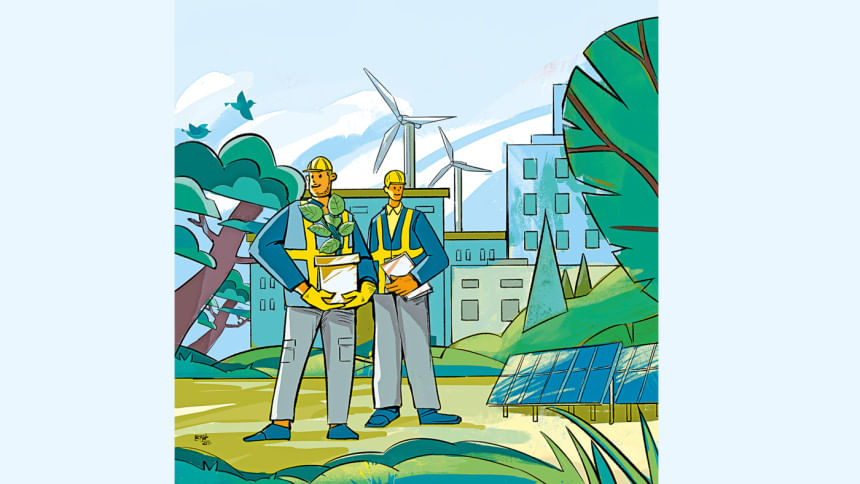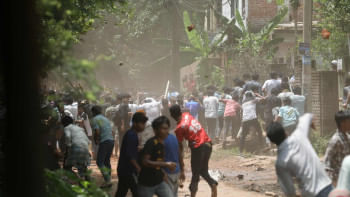Greener factories stronger future

As Bangladesh strides towards middle-income status, it must confront a reality that few nations can ignore: it is one of the most climate-vulnerable countries in the world. From rising sea levels and extreme weather events to resource scarcity and pollution, the environmental threats are severe and persistent. This fragility demands a radical rethinking of how the country industrialises. Fortunately, a green transformation is already underway.
Once criticised for lax compliance and unsafe working conditions—particularly in labour-intensive sectors such as garments and leather—Bangladesh is now emerging as an unlikely leader in sustainable industrial practices. At the forefront of this shift are its garment factories. With more than 200 factories certified by the US Green Building Council's LEED (Leadership in Energy and Environmental Design), Bangladesh now boasts the highest number of green garment factories in the world. This achievement is no longer limited to the RMG (Ready-Made Garment) sector—it is beginning to ripple through other industries as well.
Recognising this momentum, the Ministry of Labour and Employment recently awarded 30 companies with the Green Factory Award 2025, honouring those that have demonstrated tangible commitments to eco-friendly practices, worker safety, and resource efficiency. The award spans sectors including textiles, leather, pharmaceuticals, electronics, food processing, steel, ship-breaking, and diversified manufacturing.
"It's encouraging to see that these companies are genuinely performing well," said Dr Ainun Nishat, Professor Emeritus at BRAC University and one of Bangladesh's leading environmental experts. "Certifications like this promote energy efficiency, pollution control, and responsible resource use. They also have practical implications—such as maximising natural light—that benefit both the environment and the people working inside these factories."
Among this year's honourees are BSRM and Walton, leaders in the steel and electronics sectors respectively. These companies exemplify how environmentally conscious business strategies can coexist with growth and innovation.
"Our organisation has a longstanding institutional culture that actively promotes and implements environmentally friendly practices," said Aameir Alihussain, Managing Director of BSRM. "We dedicate our time, effort, and mindset to sustainability. If businesses in Bangladesh—from manufacturing to agriculture—do not adopt eco-conscious mindsets, we will face serious generational consequences."
BSRM's steel operations are known for using modern, energy-efficient processes, while Walton has invested heavily in waste reduction, water reuse, and renewable energy.
"Every year, we recycle over 8,000 tonnes of plastic and safely dispose of more than 62,000 units of e-waste," explained Md Tanvir Anjum, Business Coordinator to the Managing Director at Walton. "Our effluent treatment plant processes more than 330 million litres of wastewater annually, 75% of which is reused. That's not just sustainability—it's smart business."
Indeed, the business case for green investment is growing stronger. In an era of rising energy costs, increased environmental regulation, and changing consumer preferences, sustainable practices are no longer just ethically commendable—they're commercially necessary.
"Green practices mean becoming resource-efficient, which translates into cost savings," said Fakir Kamruzzaman Nahid, Managing Director of Fakir Fashion Limited, another award recipient. "More importantly, it ensures the wellbeing of workers and long-term growth. We've seen improved employee retention and workplace satisfaction. In today's conscious marketplace, green practices give you a definite competitive edge."
Fakir Fashion has embraced technologies such as Exhaust Gas Boilers (EGB) for steam generation using waste heat, large-scale rainwater harvesting, and a high-capacity Effluent Treatment Plant (ETP) with an 8,000 m³ treatment capacity. These investments not only help meet compliance requirements but also align with global sustainability standards—something increasingly demanded by international buyers.
However, not all sectors are progressing at the same pace. The leather industry, long considered a potential export powerhouse, has struggled due to compliance shortfalls. Without Leather Working Group (LWG) certification—required by many global importers—exports to countries like Italy have dwindled. Addressing these gaps requires urgent upgrades to the Central Effluent Treatment Plant (CETP) in Savar, improved tannery conditions, and better waste management. Experts argue that such reforms must be proactive rather than reactionary, driven by national ambition rather than external pressure.
Complementing these corporate efforts is the role of Bangladesh Bank, which has introduced green financing schemes through commercial banks. These facilities offer loans at preferential rates to industries that invest in renewable energy, pollution control, or water treatment. But industry leaders argue that incentives need to go further.
"The government can play a stronger role by providing non-refundable tax credits or direct incentives to companies that go green, rather than relying solely on punitive measures," said Aameir Alihussain.
Sustainability, however, is not a one-time achievement—it's an ongoing commitment. Dr Ainun Nishat cautioned that certificates and awards should not lead to complacency. "The real test begins after recognition. Companies must continue to uphold these standards through regular audits and ongoing training. And government inspection agencies have a vital role in ensuring compliance is maintained," he said.
As Bangladesh seeks to maintain its competitiveness on the global stage, particularly in export-driven sectors, embracing green industrialisation is not optional—it is essential. From garment factories and steel plants to electronics and leather goods, sustainability is becoming the common thread in Bangladesh's industrial growth story.
In doing so, the country is not only protecting its fragile environment but also future-proofing its industries—ensuring that economic ambition does not come at the cost of ecological destruction. By building on this momentum, Bangladesh could well become a global model for how a developing country can industrialise without compromising the health of its people or the planet.

 For all latest news, follow The Daily Star's Google News channel.
For all latest news, follow The Daily Star's Google News channel. 



Comments